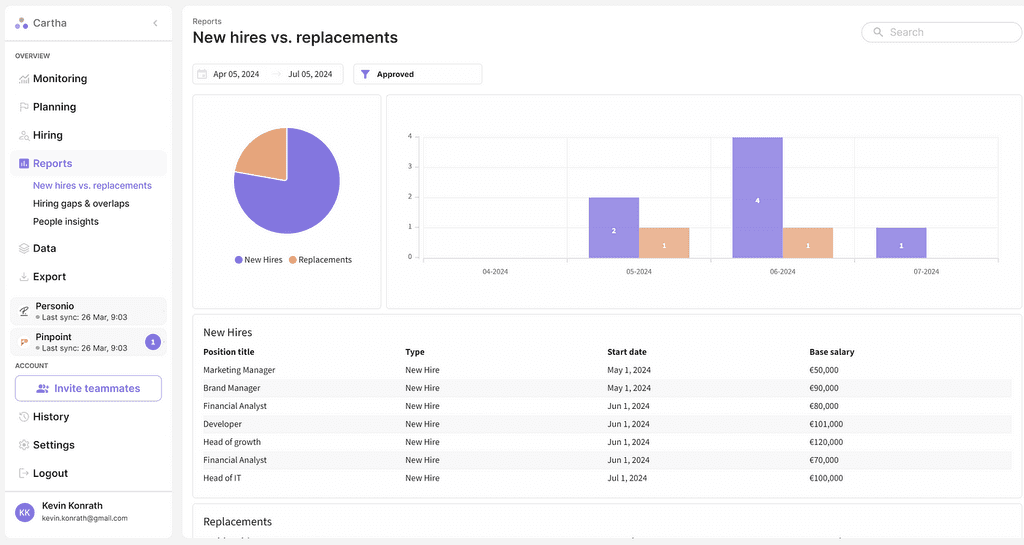
Mar 29, 2024 |
In the dynamic landscape of today’s business world, maintaining a clear overview of staffing changes, particularly new hires versus replacements, is more critical than ever. The workforce dynamics have significantly evolved over the past decades, with companies experiencing fluctuating personnel needs at a pace never seen before. This shift necessitates a precise tracking mechanism to manage one of the largest cost drivers for businesses: their people. Incorrectly tracking these changes can not only skew forecasting accuracy but, in the worst-case scenario, pose existential threats to companies through misassumed financial burn rates.

The challenges of keeping accurate records are diverse, stemming from reconciliation efforts to the nuanced intricacies of data privacy. With Human Resource Information Systems (HRIS), Applicant Tracking Systems (ATS) and spreadsheet-based Hiring Plans often not synchronized, businesses find themselves grappling with consistently out-of-sync data points. This discrepancy is further complicated by the need for finance departments to access comprehensive data while restricting access to other collaborators, balancing data privacy with operational necessity. Moreover, the limited process understanding among stakeholders, particularly budget managers, compounds these challenges, necessitating manual corrections and streamlining of inputs to ensure accuracy in budgeting and forecasting processes.
Key Takeaways
Importance of tracking new hires versus replacements is heightened in today’s fluctuating workforce, directly impacting financial forecasting and potentially the viability of businesses.
Challenges in maintaining accurate staffing records include out-of-sync data points due to disconnected HRIS and ATS systems, data privacy concerns, and a limited understanding of budgeting processes among stakeholders.
Solutions involve adopting dedicated headcount planning tools, which offer ease of implementation, facilitate simple collaboration across stakeholders, and enhance transparency while reducing time wastage.
Benefits of these tools include seamless integration into existing systems, enabling stakeholders to collaborate effectively, and providing a transparent overview of staffing changes, thereby minimizing reconciliation efforts and improving forecasting accuracy.
Problems
Large Reconciliation Efforts
The task of keeping staffing data aligned presents significant challenges, primarily due to always out-of-sync data points between different systems. The disconnect between Excel or Google Sheets, Human Resource Information Systems (HRIS) and Applicant Tracking Systems (ATS) exacerbates the difficulty in maintaining an accurate and current overview of staffing changes. This misalignment often results in extensive reconciliation efforts, consuming valuable time and resources that could be better utilized elsewhere.
Data Privacy/Sensitivity
Navigating the complex landscape of data privacy and sensitivity adds another layer of complexity to tracking new hires and replacements. While finance departments may require access to comprehensive data to ensure accurate forecasting, there’s a pressing need to restrict access for other collaborators. Balancing these conflicting requirements demands a nuanced approach, ensuring compliance with data protection regulations while facilitating effective workforce management.
Limited Process Understanding of Stakeholders
A significant barrier to effective staffing management is the limited process understanding among key stakeholders, particularly budget managers. Often overwhelmed by the complexities of budgeting and forecasting processes, business managers may lack the focus to grasp the details necessary for precise financial planning. This gap in understanding necessitates manual corrections and streamlining of inputs by Finance, further complicating the headcount management process.
Solutions
Considering dedicated headcount planning tools emerges as a viable solution to the myriad challenges associated with tracking new hires versus replacements. These tools are designed to integrate seamlessly with existing systems, reducing the effort and complexity involved in managing staffing data. By facilitating simple collaboration across different stakeholders and enhancing transparency, dedicated headcount planning tools can significantly reduce the time wasted on reconciliation efforts and improve the accuracy of financial forecasting.

Headcount planning tools, like Cartha, make it easy to seamlessly connect with existing systems and keep your people planning efforts in a single source of truth
Benefits
The adoption of dedicated headcount planning tools offers numerous benefits. These tools are engineered to plug into existing systems effortlessly, minimizing the need for extensive training or significant changes to existing processes. Additionally, they enable simple collaboration across stakeholders, ensuring that all relevant parties have access to the information they need without compromising data privacy. This increased transparency and collaboration efficiency not only streamlines the management of staffing changes but also contributes to a more accurate and efficient financial forecasting process, ultimately safeguarding the financial health of the company.
Conclusion
In the face of today’s rapidly changing workforce dynamics, maintaining a precise overview of new hires versus replacements is vital. The complexities of data synchronization, privacy concerns, and stakeholder understanding present significant challenges, yet the solution lies in embracing technology. Dedicated headcount planning tools offer a path to streamlined processes, ensuring that companies can navigate the intricacies of workforce management with greater ease and accuracy. By implementing these tools, businesses can safeguard against financial missteps, ensuring a stronger, more resilient future. As we look ahead, the call to action for businesses is clear: invest in technology that simplifies, clarifies, and enhances the management of your most valuable asset — your people.
FAQs
What makes dedicated headcount planning tools different from traditional HRIS systems?
Dedicated headcount planning tools are specifically designed to manage staffing changes efficiently, offering features like seamless integration with existing systems, enhanced collaboration capabilities, and improved transparency, which are not always a focus in traditional HRIS systems.
How can companies ensure data privacy while using headcount planning tools?
Companies can ensure data privacy by utilizing headcount planning tools that offer customizable access levels, ensuring that sensitive information is only accessible to authorized personnel, and by adhering to best practices in data protection and compliance.
What are the first steps in implementing a headcount planning tool in an organization?
The first steps include assessing the organization’s specific needs, selecting a tool that aligns with these requirements and existing systems, and developing a rollout plan that includes training for stakeholders to ensure smooth adoption and integration.







